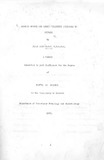| dc.description.abstract | It is not possible to guess the annual loss of livestock caused by poisonous plants in East Africa but it is considerable. Investigation has also shown that some of these plants have been used for medicinal and homicidal purposes in the East African countries as well as other parts of the world.
The impetus for research on species of plants from the genera Soneoio and Adenia has been the recognition of possible hopatatoxic actions as a result of ingestion of the Senecio species and the acute toxic effects caused by ingestion of Adenia species. The possibilities that dangerous toxic principles in form of alkaloids and glycosides may be contained in those plant species also needed exploration.
Cattle, pigs, sheep, rabbits and rats were used to study the pathologic effects of these plants which were obtained from various parts of Kenya. The ways of preparation of plant material for experiment were either by cutting it into small pieces; sun-drying followed by grinding into fine powder or extraction. Animals were dosed by either injections, drenching or incorporating the material in the basal diets. The toxicity in animals was evaluated by their effect on the growth rate, histopathology,
haematology, changes in serum enzymes, gross pathology and histopathology.
Pathological changes were induced in certain organs of the experimental animals by both species, namely, Senecio moorei and Adenia valtensii. *In large animals, when trials were conducted for several months using Senecju) moorei, the most significant lesions were observed in liver (cattle) and kidney (pigs); also present were serous effusions in the peritoneal and pleural cavities (cattle). The pathological changes in livers of cattle were portal fibrosis and slight to extensive bile duct proliferation. Varying degrees of degeneration and regeneration of hepatic cells were also noted in all animals fed Senecio powder. In swine a daily intake of Senecio powder produced some enlargement of nuclei of some hepatic cells and also enlargement of nuclei of proximal convoluted tubules of the kidneys. There was also slight epithelialization of the alveoli of lungs.
In rats trials were conducted for acute and chronic Serecio moorei poisoning. In chronic poisong Senecio powder was incorporated into basal diet making up from 1% to of the ration. Tumours developed mainly in the liver. Most hepatic tumours were hepatomas (hepatocellular carcinomas), bile duct adenomas and fibromas. There was no any metastasis observed.
In sheep, rabbits and rats, trials using Adenia volkensii material
produced lesions ranging from congestion to haemorrhages of various
internal organs of these animals.
An exploration into the toxic principles contained in senecio moorei and Adenia volkenaii showed tint Senecio moorei contained three basic compounds (alkaloids). Unfortunately these bases were not purified. Adenia volkensii was found to contain a high concentretion of hydrocyanic acid, either as free or more likely in form of cyanogenetic glycoside.
The study suggests the need for additional research on tropical poisonous plants in relation to animal and human diseases and further investigation into the basic compounds present in Senecio moorei aimed at purification of the compounds. | |

